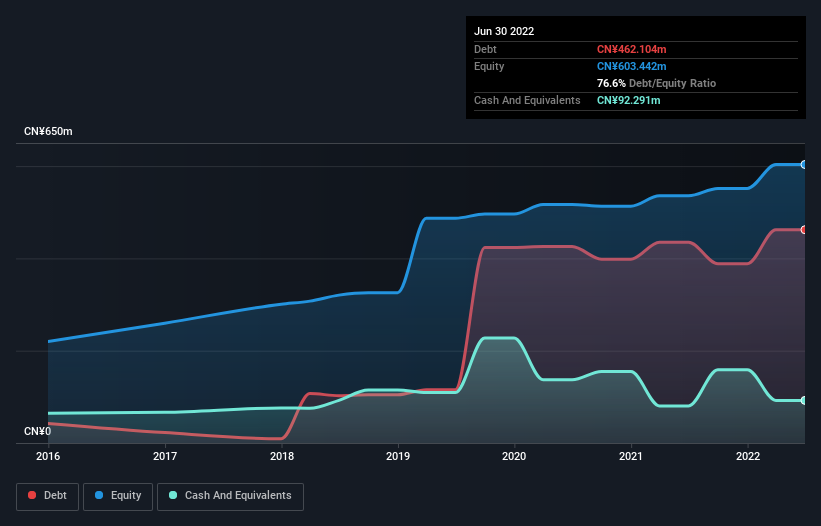- Hong Kong
- /
- Consumer Services
- /
- SEHK:1851
Is China Gingko Education Group (HKG:1851) Using Too Much Debt?

Howard Marks put it nicely when he said that, rather than worrying about share price volatility, 'The possibility of permanent loss is the risk I worry about... and every practical investor I know worries about.' So it seems the smart money knows that debt - which is usually involved in bankruptcies - is a very important factor, when you assess how risky a company is. We note that China Gingko Education Group Company Limited (HKG:1851) does have debt on its balance sheet. But the real question is whether this debt is making the company risky.
Why Does Debt Bring Risk?
Debt assists a business until the business has trouble paying it off, either with new capital or with free cash flow. If things get really bad, the lenders can take control of the business. However, a more common (but still painful) scenario is that it has to raise new equity capital at a low price, thus permanently diluting shareholders. Of course, plenty of companies use debt to fund growth, without any negative consequences. When we examine debt levels, we first consider both cash and debt levels, together.
View our latest analysis for China Gingko Education Group
What Is China Gingko Education Group's Debt?
As you can see below, at the end of June 2022, China Gingko Education Group had CN¥462.1m of debt, up from CN¥435.1m a year ago. Click the image for more detail. However, because it has a cash reserve of CN¥92.3m, its net debt is less, at about CN¥369.8m.

A Look At China Gingko Education Group's Liabilities
According to the last reported balance sheet, China Gingko Education Group had liabilities of CN¥256.3m due within 12 months, and liabilities of CN¥331.2m due beyond 12 months. Offsetting this, it had CN¥92.3m in cash and CN¥2.86m in receivables that were due within 12 months. So it has liabilities totalling CN¥492.4m more than its cash and near-term receivables, combined.
When you consider that this deficiency exceeds the company's CN¥343.7m market capitalization, you might well be inclined to review the balance sheet intently. Hypothetically, extremely heavy dilution would be required if the company were forced to pay down its liabilities by raising capital at the current share price.
We use two main ratios to inform us about debt levels relative to earnings. The first is net debt divided by earnings before interest, tax, depreciation, and amortization (EBITDA), while the second is how many times its earnings before interest and tax (EBIT) covers its interest expense (or its interest cover, for short). This way, we consider both the absolute quantum of the debt, as well as the interest rates paid on it.
With net debt to EBITDA of 3.2 China Gingko Education Group has a fairly noticeable amount of debt. But the high interest coverage of 7.1 suggests it can easily service that debt. Notably, China Gingko Education Group's EBIT launched higher than Elon Musk, gaining a whopping 150% on last year. The balance sheet is clearly the area to focus on when you are analysing debt. But it is China Gingko Education Group's earnings that will influence how the balance sheet holds up in the future. So when considering debt, it's definitely worth looking at the earnings trend. Click here for an interactive snapshot.
Finally, while the tax-man may adore accounting profits, lenders only accept cold hard cash. So the logical step is to look at the proportion of that EBIT that is matched by actual free cash flow. Over the last three years, China Gingko Education Group saw substantial negative free cash flow, in total. While that may be a result of expenditure for growth, it does make the debt far more risky.
Our View
To be frank both China Gingko Education Group's level of total liabilities and its track record of converting EBIT to free cash flow make us rather uncomfortable with its debt levels. But on the bright side, its EBIT growth rate is a good sign, and makes us more optimistic. Looking at the bigger picture, it seems clear to us that China Gingko Education Group's use of debt is creating risks for the company. If all goes well, that should boost returns, but on the flip side, the risk of permanent capital loss is elevated by the debt. When analysing debt levels, the balance sheet is the obvious place to start. But ultimately, every company can contain risks that exist outside of the balance sheet. For instance, we've identified 3 warning signs for China Gingko Education Group that you should be aware of.
At the end of the day, it's often better to focus on companies that are free from net debt. You can access our special list of such companies (all with a track record of profit growth). It's free.
New: AI Stock Screener & Alerts
Our new AI Stock Screener scans the market every day to uncover opportunities.
• Dividend Powerhouses (3%+ Yield)
• Undervalued Small Caps with Insider Buying
• High growth Tech and AI Companies
Or build your own from over 50 metrics.
Have feedback on this article? Concerned about the content? Get in touch with us directly. Alternatively, email editorial-team (at) simplywallst.com.
This article by Simply Wall St is general in nature. We provide commentary based on historical data and analyst forecasts only using an unbiased methodology and our articles are not intended to be financial advice. It does not constitute a recommendation to buy or sell any stock, and does not take account of your objectives, or your financial situation. We aim to bring you long-term focused analysis driven by fundamental data. Note that our analysis may not factor in the latest price-sensitive company announcements or qualitative material. Simply Wall St has no position in any stocks mentioned.
About SEHK:1851
China Gingko Education Group
An investment holding company, provides private higher education services in the People's Republic of China.
Excellent balance sheet and slightly overvalued.
Market Insights
Community Narratives



